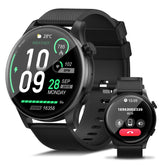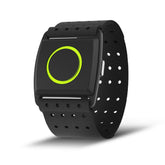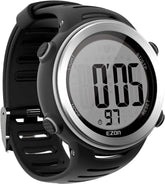Swim Training Revolution: Waterproof Sports Watches & Stroke Analysis
Transform your swimming with data-driven precision! Waterproof sports watches offer lap tracking, stroke count, and HR data to refine technique and optimize effort in both pool training and open water swimming. Dive into the future of swim training!
1. The Power of Waterproof Sports Watches
A. Lap Tracking & Stroke Analysis
- Auto-Lap Technology: Counts laps and measures average pace per 50m—critical for interval training (e.g., 10x100m with 20-second rest).
- Stroke Count: Track strokes per length to improve efficiency (aim for <30 strokes/50m in freestyle).
- SWOLF Score: Combines time + strokes (lower score = better efficiency). Use your watch to set SWOLF goals (e.g., reduce score by 5 points in 4 weeks).
B. Heart Rate Monitoring in Water
-
Chest Strap vs. Wrist-Based:
- Chest straps (e.g., Polar H10) provide accurate HR data for intense sets; wrist-based watches (EZON Waterproof Series) are convenient for casual swims.
-
Heart Rate Zones for Swimmers:
- Zone 2 (60–70% MHR): Endurance sets (e.g., 30-minute continuous swimming).
- Zone 4 (80–90% MHR): Sprint intervals (e.g., 8x50m all-out with 1-minute rest).
2. Stroke Efficiency: The Key to Faster Times
A. Freestyle Technique Refinement
- Body Position: Use stroke count to ensure high elbows and minimal drag—every extra stroke adds 0.5 seconds/length.
- Kick-to-Stroke Ratio: Aim for 2 kicks per stroke (flutter kick) to conserve energy, tracked by watch accelerometers.
B. Open Water Specific Drills
- Sighting Practice: Lift your head every 6 strokes to sight buoys; use watch lap data to measure off-course distance (aim for <5% deviation).
- Drafting Technique: Swim 1–2 meters behind a competitor to reduce drag—HR data should show 5–10 BPM lower than solo effort.
3. HR Data: Balance Intensity and Recovery
A. Training Load Management
- Cumulative Stress Score: Avoid exceeding 10% weekly intensity increase—use HR data to prevent overtraining (e.g., the "polarized" model: 80% easy, 20% hard).
- Recovery Intervals: Rest until HR drops to Zone 2 (60–70% MHR) between sets—critical for lactic acid clearance.
B. Post-Swim Recovery
- HRV (Heart Rate Variability): High HRV (>50) means ready for intensity; low HRV (<40) signals need for yoga or foam rolling.
- Sleep Staging: Ensure 15–20% deep sleep for muscle repair—use watch insights to adjust bedtime (e.g., 10 PM lights-out for 7-hour sleep).
4. Training Plans: Pool vs. Open Water
A. 12-Week Pool Training Plan
Weeks 1–4: Technique Focus
-
Key Sets:
- 4x200m freestyle with stroke count focus (target 28 strokes/50m).
- 6x50m kick sets (no arms) to improve leg strength.
- HR Goal: Keep 80% of sessions in Zone 2–3 (60–80% MHR).
Weeks 5–8: Intensity Build
- HIIT Sessions: 10x100m at Zone 4 (85% MHR), 30-second rest—use watch lap alerts for consistency.
- SWOLF Challenge: Weekly time trials to track efficiency gains.
Weeks 9–12: Race Simulation
- 1,500m TT: Swim at goal race pace, analyzing HR drift (should stay within 5 BPM of target).
- Open Water Practice: Transition drills (pool to open water) to acclimate to temperature and currents.
B. Open Water Training Tips
- Cold Water Acclimation: Start with 10-minute swims in cold lakes, monitoring HR for signs of stress (HR >90% MHR = exit water).
- GPS Route Mapping: Use a waterproof sports watch to pre-plan buoy routes and measure distance accuracy.
5. Gear Recommendations
A. Top Waterproof Sports Watches
| Model | Key Features | EZON Series Link |
|---|---|---|
| EZON Swim Pro | Lap tracking, SWOLF score, 10ATM rating | Shop Now |
| EZON Open Water | GPS, open water mode, HRV analysis | Shop Now |
B. Accessories
- Swim Pacing Trainer: Attach to goggles for real-time pace alerts during pool sets.
- Neoprene HR Strap: Ensures chest strap stays in place during open water swims.
6. Common Mistakes to Avoid
-
Ignoring Stroke Count for Speed:
- Solution: Prioritize efficiency over pace—use SWOLF score to guide technique improvements.
-
Overtraining in Open Water:
- Solution: Limit cold water swims to 3x/week; use HR data to avoid hypothermia (HR drops >10 BPM from baseline).
-
Neglecting Dryland Training:
- Solution: Add 2x/week strength sessions (pull-ups, core) to improve power-to-weight ratio, tracked via watch activity metrics.
7. FAQs: Your Swim Data Questions Answered
Q: Can I use a regular smartwatch for swimming?
- No—waterproof sports watches are designed for pool/open water with specialized metrics like stroke count and SWOLF.
Q: How often should I analyze stroke data?
- After every main set—use post-swim reports to identify trends (e.g., increased strokes on tired days).
Q: What’s the ideal HR for open water endurance swims?
- Zone 2–3 (60–80% MHR) to maintain steady effort and avoid early fatigue.
Swim Smarter, Swim Faster
With waterproof sports watches and HR data, you’ll turn every lap into a step toward perfection. Use stroke analysis to eliminate inefficiencies, HR zones to manage intensity, and GPS to master open water routes. Whether training for a triathlon or chasing a pool PB, let technology be your coach.
Dive in, track your progress, and let data-driven training revolutionize your swim performance. The pool and open water await—train with precision, race with confidence, and redefine what’s possible in the water.
EZON Watch: Professional sports technology brand
https://ezonwatch.com
https://ezonwatch.com









